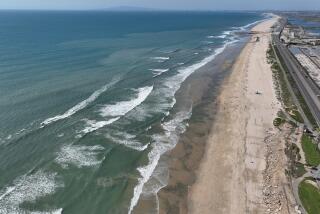BP pulls back oil spill cleanup operation
Reporting from Barataria Bay, La., and Los Angeles — As visible slicks on the surface of the Gulf of Mexico disappear, BP is scaling back its massive cleanup effort, pulling out miles of protective orange boom from the coastline and cutting the number of ships scouting for oil and the hiring of crews scouring the beaches.
“We haven’t seen oil flow in the gulf since the 15th of July,” said BP’s incoming Chief Executive Bob Dudley in his first news conference since he was named to replace the widely criticized Tony Hayward. “You’ll see the evidence of a pullback because we have boom across the shores, all the way from Florida to Louisiana. Those only last for a certain number of tide cycles.
“And where there is no oil on the beaches, you probably don’t need people walking up and down with hazmat suits,” he said.
But the Mississippi-raised executive was quick to add that the company is “not stopping cleanup operations by any means. We are not complacent about this at all.”
In a Friday briefing, retired Adm. Thad Allen, the Obama administration’s point man on the spill, cautioned: “We are going to make sure this well is completely sealed. Until we have no more oil on the surface of the water, until we understand where all the oil has gone, until the beaches are clean.… We are still engaged in the fight.”
Aircraft looking for slicks made 103 sorties on Thursday and were scheduled to make 98 trips on Friday, Allen said. Federal officials said Friday that surface oil had mostly degraded to a thin sheen.
As cleanup efforts contracted, biologists began to voice concern that stretches of damaged, oil-soaked boom are washing ashore, intruding on sensitive wildlife habitat and delicate marshland grasses. Stormy weather and exposure to oil, sun and choppy seas have degraded the plastic barriers.
On a recent calm, sunny day in Barataria Bay, La., about 50 miles south of New Orleans, orange boom could be seen twisted into the shrubs on Mangrove Island, a 5-acre patch of land teeming with adult and adolescent pelicans.
But efforts to pull the boom out could have crews trampling new nesting areas and crushing delicate grasses. Leaving it behind means that birds and other wildlife mingle with oily debris.
Drew Wheelan, a conservationist with the American Birding Assn., said he witnessed a cleanup crew last week pull soft oily boom out of a pelican nesting area on an island in Barataria Bay. After the crew left, he saw several baby pelicans, too young to leave the nest, flailing in the mud.
“They didn’t have any feathers to be able to keep the water out of their skin” — a virtual death sentence, Wheelan said.
It has been a challenge to get cleanup crews to maintain the boom regularly. “Boom is only good as well as it is maintained,” said Todd Baker, a biologist program manager with the Louisiana Department of Wildlife and Fisheries. “If it’s not maintained, it’s worthless.”
Robert Love, a biologist administrator for the state wildlife department, said: “We call it in, and call it in, and they’re just slow. It’s very frustrating.”
Biologists have told crews to keep their distance, advising them it’s better to wait to take out the boom until baby birds have left nearby nests. But biologists aren’t always with the workers, and mistakes can happen.
Allen acknowledged other problems with the boom earlier in the week. “If you leave boom unattended in a very sensitive area, and there is a high surge, sometimes just the mechanical action of the boom itself being dragged over the marshes may be something that’s not desirable,” he said.
On Friday, Allen said authorities had begun to pull out some of the 11 million feet of existing boom “in a very, very deliberate planning process.” In some cases, he added, boom that was removed in anticipation of a storm will not be replaced because of ecological concerns.
As boom is retired, he said, it will be decontaminated. Some will be stored for future use. Damaged boom will be recycled to recover the plastic.
Allen said that a “static kill” operation to seal the well that was planned for this weekend would be delayed until late Monday or Tuesday to clear out debris found at the bottom of the well bore after the last storm.
A relief well, designed to intercept the gushing well 17,000 feet below the gulf’s surface and permanently halt the spill, is currently 4 1/2 feet away from the original well and 100 feet above the point of interception with the 7-inch drill pipe, Allen said.
On Thursday, Louisiana officials, in coordination with the federal Food and Drug Administration, reopened 2,400 square miles of state coastal waters to commercial fin-fishing and shrimping, although fishing for crabs and oysters remains banned.
“It really is something to celebrate,” said FDA chief Margaret Hamburg at a New Orleans news conference Friday.
But she cautioned, “We always have to be vigilant. Just because the waters are safe for reopening fishing today doesn’t mean that something can’t change.”
Commercial fishing remains restricted in 84,000 square miles of federal fishing waters, as well as in state coastal waters south of the Mississippi River, where oil slicks are still washing into sensitive marshes.
More to Read
Sign up for Essential California
The most important California stories and recommendations in your inbox every morning.
You may occasionally receive promotional content from the Los Angeles Times.












